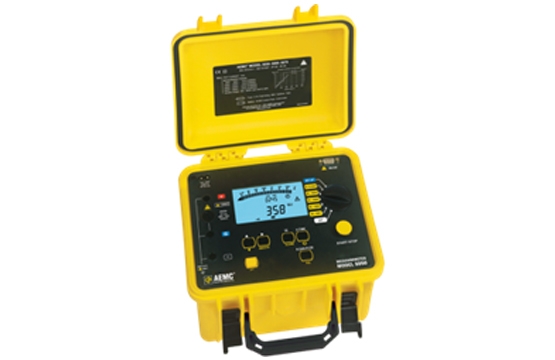

One of the most widely known test methods applied to electric motors is the resistance to ground (RTG) test. It is commonly referred to as a “megger” test, because one of the meg-ohmmeter manufacturers, Biddle, named their product a “Megger,” and the name stuck. Biddle is now called Megger. Resistance to ground testing can be performed by standalone instruments and is incorporated in types of equipment that provide comprehensive motor testing as part of their suite of tests. The meg-ohmmeter works by applying test voltage to the device which then measures the amount of current that returns from the ground to the instrument. Using basic ohms law, the current is equal to the voltage divided by the resistance or I = E/R. This applies to voltage too, the lower the resistance to ground; the higher the current.
Insulation resistance is affected by several variables such as temperature and humidity. Humidity cannot be compensated for and as such will require testing when humidity is low. However, temperature effects can easily be compensated. Many insulation test instruments provide a means of temperature correction. The simple reason is because of the relationship between resistance and temperature. With varying temperatures inside the motor, resistance measurements will also vary. Since so much of motor testing is about trending changes over time, we need some way to equalize them. What’s typically done, depending on the instrument in use, is to correct the measurements to 40°C for comparison. This is achieved by a mathematical calculation performed within the test instrument software. That equation can be approximately as follows:
KT+(0.5)(40-T)/10
Where: T= winding resistance at the time of testing
KT= insulation resistance coefficient at Temperature T C°
RTG Calculation:
RTG= KT/RT
Where: RTG= Insulation resistance in Meg-Ohms corrected to 40°C
KT= insulation resistance coefficient Temperature T C°
RT= measured insulation resistance in Meg-Ohms at temperature T C°
If that isn’t clear to you, no need to worry. The test instrument does the math for us. It’s imperative however that we give the instrument good data. The motor temperature measurement needs to be as accurate as possible. Ideally, we’d love to have thermocouples inside of every motor we test. I don’t see a lot of that, so we need to measure it at the time of the test. Control all the variables you can so that the data is meaningful. Measure the temperature at the motor, at the same place on each motor every time if possible. Radiometric measurement is fine if you have an IR imager or spot radiometer. Just be careful to be working within the measurement resolution of the instrument. If you have a thermocouple that can be attached to the motor, that’s even better. Then enter the measurement into the motor tester software.
Motor test instruments that perform this function will then provide you with two values for RTG. One is the measured RTG, and the other is the temperature-corrected RTG. Trending the corrected value is what is recommended to detect defects that may develop over time. A trend of decreasing RTG values over time can be indicative of contamination in the form of dirt or moisture and indicative of insulation degradation. All motor failure mechanisms will cause a motor to run at higher temperatures. Exceeding the design parameters for insulation temperature cause the insulation to become embrittled which will lead to insulation breakdown and ultimate failure. Timed Resistance testing is a means of overcoming the necessity of temperature correction. When you are time constrained and can only take a minimal resistance to ground check, temperature is of critical importance for trending.